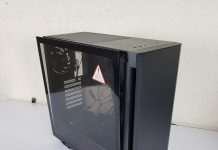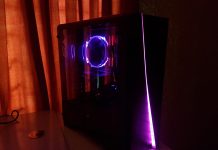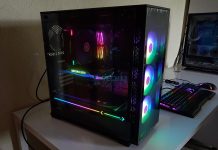Getting a PC case is essential. It holds all the components inside and is the first thing anyone notices about your build. A few factors are to be considered before buying the best case; these factors include the design, the airflow, and the case’s size. However, the most important factor is the performance aspect of the case and if it cools all the components that it houses. For this, I put together a variety of cases that focus on airflow, intensively tested them, and then picked my top 6 options that cover various categories.
Here are my picks for Airflow PC Cases, all compared to each other with their best use:












Best PC Cases For Airflow
The following are my recommendations for the Best Airflow PC Cases:
- Best Mid-Tower Airflow Case: LIAN LI LANCOOL III
- Best Value Airflow Case: Corsair 4000D Airflow
- Best White Airflow Case: NZXT H5 Flow
- Best Full Tower Airflow PC Case: Corsair 7000D Airflow
- Best ATX Case For Airflow: Corsair 6500D Airflow
- Best Mini-ITX Airflow Case: Corsair 2000D Airflow
LIAN LI LANCOOL III
Best Mid-Tower Airflow Case
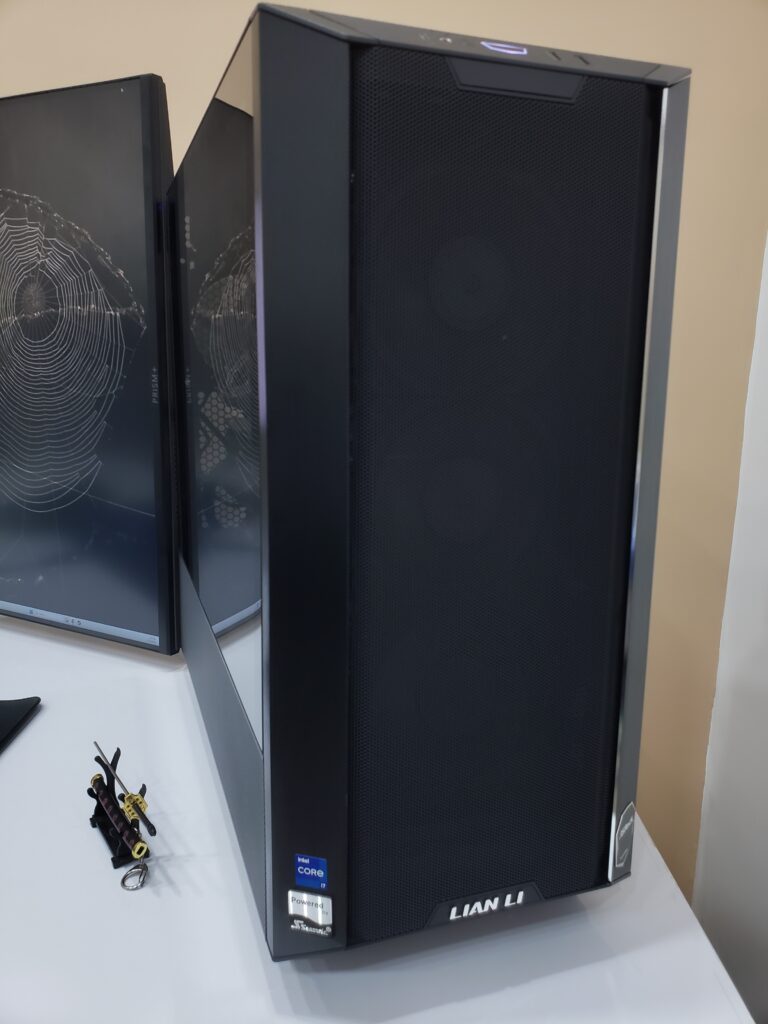
Specifications : Type: Mid-tower ATX | Colors: Black, White | Motherboard Support: Mini-ITX, Micro-ATX, ATX, E-ATX | Dimensions: 526 x 238 x 523 mm | GPU Clearance: 435mm | CPU Cooler Clearance: 187mm | PSU Clearance: 220mm | Drive Bays: 8x 2.5” SSDs and 4x 3.5” HDDs or 12x 2.5″ SSDs | Included Fans: 4x 140mm PWM fans
Pros
- Extensive Mesh Design
- Support for 10x fans
- Support for 3x 360mm and or 2x 420mm radiators
- Lots of GPU, PSU, and CPU Cooler clearance
Cons
- Bulky
Aesthetics & Build Quality: The Lian Li LANCOOL III stands at 523mm and shows a beautiful, sleek aesthetic, the highlight of which is its tempered glass side panel and its mesh front panel. With three of its pre-included fans shining through the front mesh, the chassis looks great and it showed me a tough build quality.
Cooling Performance: Lian Li has gone all out with the mesh design with front, top, and two bottom side panel meshes. The chassis comes with 4x 140mm fans, with room for an additional six, plus support for up to 2x 420mm radiators. Testing it with an air cooler and the pre-installed fans, my results showed quiet and cool performance.
Features: We get four pre-installed PWM fans and the chassis also comes with magnetic filters. For the storage front, you can install up to 12x 2.5″ SSDs, plus you have the ability to remove 3x of these trays for even better airflow. I also loved the excess of cable management features, including plenty of velcro straps and cutouts.
For a mid-tower chassis, the LANCOOL III is a powerhouse when it comes to cooling, with multiple meshes and impressive support for up to two 420mm radiators.
– Faizan Ahmed
What Makes It The Best Mid-Tower Airflow Case?
All things considered, if you’re looking for the best overall mid-tower case that is built for superb airflow, then the LANCOOL III should be your choice. The case uses an extensive mesh design in combination with exceptional cooling capabilities, and that’s why I have awarded it as the winner of the Best Mid-Tower Airflow Case.
| Connectivity: 8/10 | Value: 8/10 |
| Features: 9/10 | Design: 8/10 |
Corsair 4000D Airflow
Best Value Airflow Case
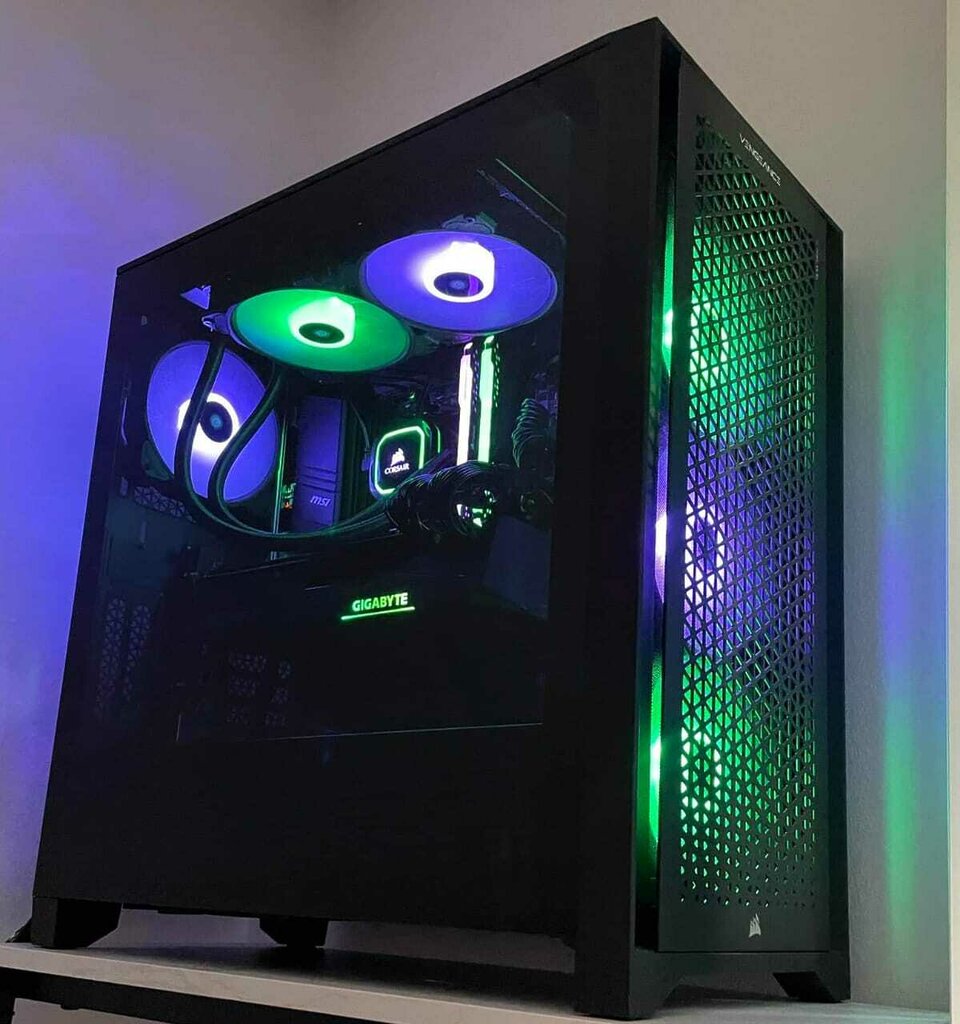
Specifications : Type: Mid-tower ATX | Colors: Black | Motherboard Support: Mini-ITX, Micro-ATX, ATX | Dimensions: 466 x 453 x 230 mm | GPU Clearance: 360mm | CPU Cooler Clearance: 170mm | PSU Clearance: 220mm | Drive Bays: 2x 2.5” SSDs and 2x 3.5” HDDs | Included Fans: 2x 120mm fans
Pros
- Perforated Front And Top Panel
- Good Value For Money
- Build Quality
- Minimalistic Design
Cons
- Only 1x USB 3.0 Port
- No RGB
Cooling Performance: The 4000D Airflow is just another chassis from Corsair that blew me away. It features perforated panels up front and top, with a triangular design and a tempered glass side panel. The chassis offers black and white options and its construction is super solid.
Cooling Performance: Not only does it have perforated panels, the 4000D Airflow also has large gaps on both sides of the triangular design for added ventilation, and plenty of room on the rear side. There is support for up to 6x 120mm fans, and I filled up all these slots for testing, which ensured that even the GPU remained under 60°C during stress.
Features: Regarding the features, I was rather disappointed with the I/O, as there is only one USB 3.0 port. Storage options include 2x 2.5″ and 2x 3.5″ trays, which is just enough. Other than that, the inclusion of 2x 120mm AirGuide fans is appreciable, and the cable management features are also quite good.
What Makes It The Best Value Airflow Case?
With that said, if you want a no-nonsense PC case to cool down your high-end rig, then you should go with the Corsair 4000D Airflow. Given its ventilation, the pricing is really good, and that’s why I selected it as the winner of the Best Value Airflow Case.
| Connectivity: 7/10 | Value: 8/10 |
| Features: 8/10 | Design: 9/10 |
NZXT H5 Flow
Best White Airflow Case
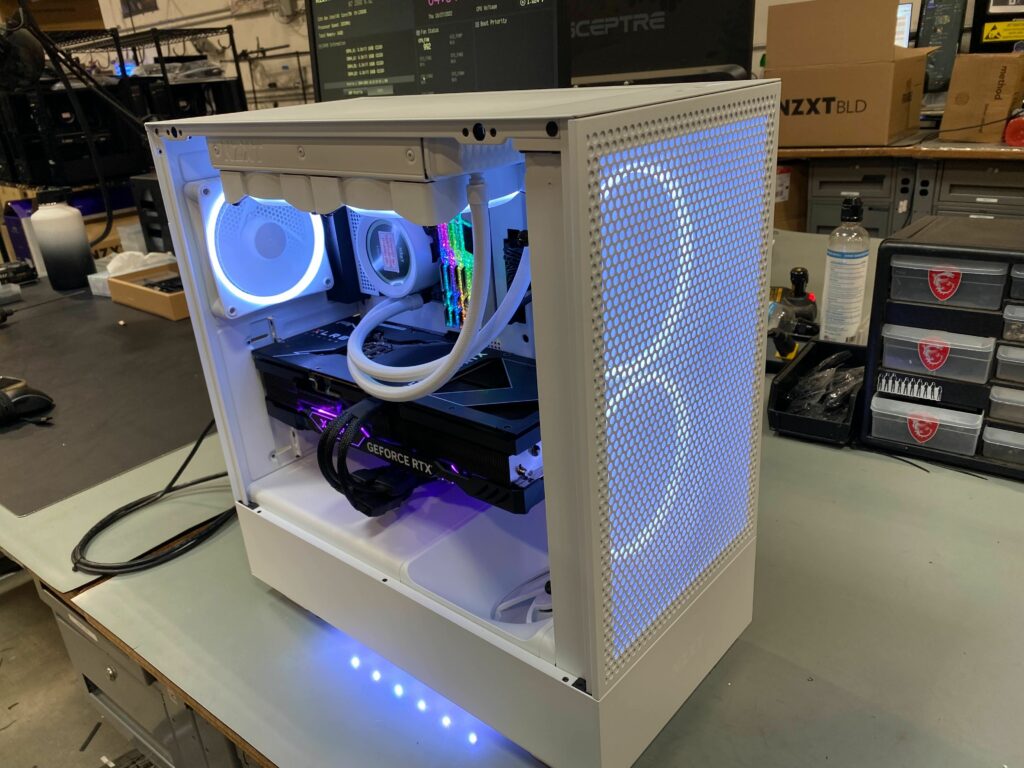
Specifications : Type: Mid-tower ATX | Colors: White | Motherboard Support: Mini-ITX, Micro-ATX, ATX | Dimensions: 464 x 447 x 227 mm | GPU Clearance: 365mm | CPU Cooler Clearance: 165mm | Drive Bays: 2x 2.5” SSDs or 1x 3.5” HDD and 1x 2.5″ SSD | Included Fans: 2x F120Q 120mm fans
Pros
- Fully Metal Mesh Design
- Beautiful White Body
- 6x Fans and 2x Radiators Support
Cons
- Only 1x Type-A Port
- Only 2 Storage Trays
Aesthetics & Build Quality: The H5 Flow is a compact ATX case with which NZXT is kept a strong focus on looks. It has a minimalistic white design, and by that I mean literally every part of the chassis is white, which looks gorgeous. Build quality is solid as I’m used to with NZXT.
Cooling Performance: On the cooling front, both the H5 Flow’s front and top panels have a perforated metal mesh cover. The chassis comes with two fans, with room for six more, including two 140mm ones. My testing showed good airflow performance, and the angled fan kept the GPU in my test build running smoothly.
Features: As mentioned, we get two fans with the chassis, including an angled one to keep the GPU cool. What I did not like is that this angled fan limits storage options: only 2x 2.5″ SSD or 1x 2.5″ SSD plus 1x 3.5″ HDD supported. The two additional dust filters (for the PSU and angled fan) are a nice touch.
What Makes It The Best White Airflow PC Case?
The NZXT H5 Flow, as its name suggests, is a great PC case designed for unrestricted airflow. Therefore, if you’re building a gaming PC with all-white components like a white CPU cooler, then you should consider going with the NZXT H5 Flow. The fully-mesh design, beautiful looks, and good cooling capabilities lead me to pick it as the Best White Airflow PC Case.
| Connectivity: 7/10 | Value: 8/10 |
| Features: 8/10 | Design: 9/10 |
CORSAIR 7000D Airflow
Best Full Tower Airflow PC Case
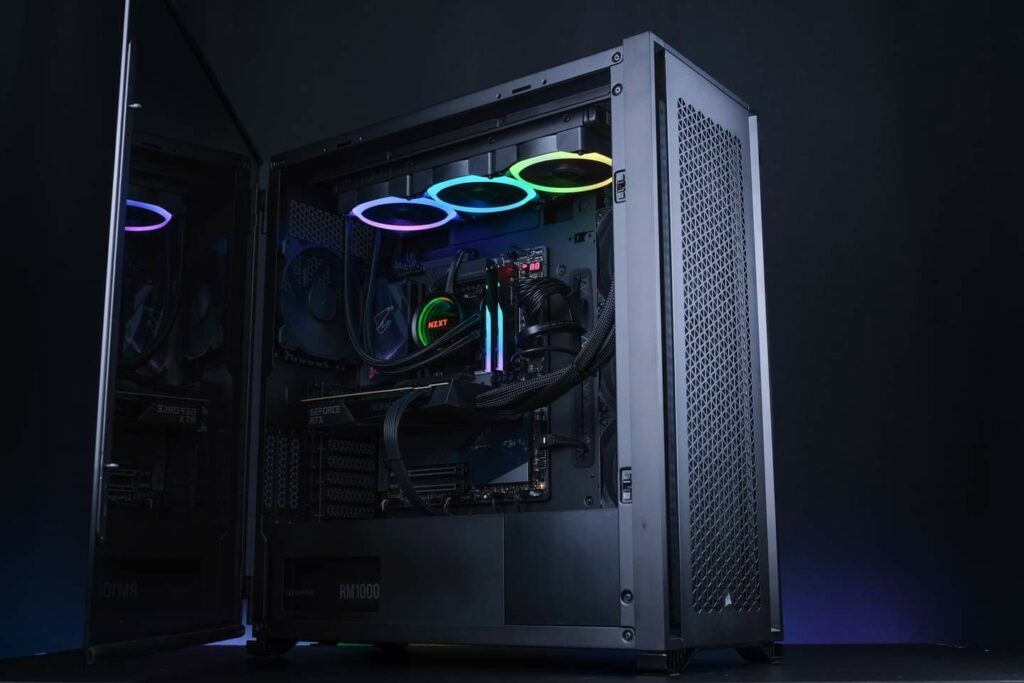
Specifications : Type: Full Tower | Motherboard Support: ATX, MicroATX, Mini-ITX, E-ATX | Dimensions: 600 x 248 x 550 mm | GPU Clearance: 450 mm | CPU Cooler Clearance: 190 mm | PSU Clearance: 225 mm | Ports: 4x USB 3.0, Optional USB-C, 3.5 mm Audio/Mic Combo | Drive Bays: 4x 2.5-inch, 6x 3.5-inch | Included Fans: Total 3x – 2x 140 mm fans (front) and 1x 140 mm fan (back)
Pros
- Easy to install components
- Very Spacious
- Dual Vertical GPU mounts
- Maximum airflow
Cons
- Expensive
- Simple design
Aesthetics & Build Quality: As with the 4000D Airflow, the first thing you notice is its front panel with large triangular cutouts, and the same pattern follows at the top. Still, the chassis’ minimalistic design is one I love, and we do get a tempered glass side panel, too. With its towering price tag, I also immediately noticed its incredible build quality.
Cooling Performance: The 4000D Airflow’s full-tower build ensures plenty of room for airflow, and its mesh panels also help a lot. Its front and top house up to four 120mm fans each, and the rear supports a 140mm fan (pre-installed). All these ensured it kept all the components cool in my test build, even under stress.
Features: Whether its the three pre-installed fans, four front I/O USB 3.0 ports, dual vertical GPU mounting support, or the included fan hub, the Corsair 4000D Airflow offers a plethora of impressive features. We get 8 expansion slots and four vertical slots. I also enjoyed the amount of space available for cable management.
While the Corsair 4000D Airflow may not have the most flashy design, it serves its purpose and lives up to its name as it showed excellent results in my thermal benchmarks.
– Faizan Ahmed
What Makes It The Best Full-Tower Airflow PC Case?
Overall, as the name suggests, the CORSAIR 7000D Airflow provides great airflow, and the full-tower features are completely present. As for the design, it is pretty simple, with only the Mesh design being slightly stylish. They could have made it a bit more appealing. However, its performance and the number of components we can stack on it fill the design gaps. Therefore, the CORSAIR 7000D Airflow has successfully made its name in the big leagues, winning the best full-tower airflow PC case award.
Best Full-Tower PC Case| Connectivity: 8/10 | Value: 7/10 |
| Features: 9/10 | Design: 8/10 |
Corsair 6500D Airflow
Best ATX Case For Airflow
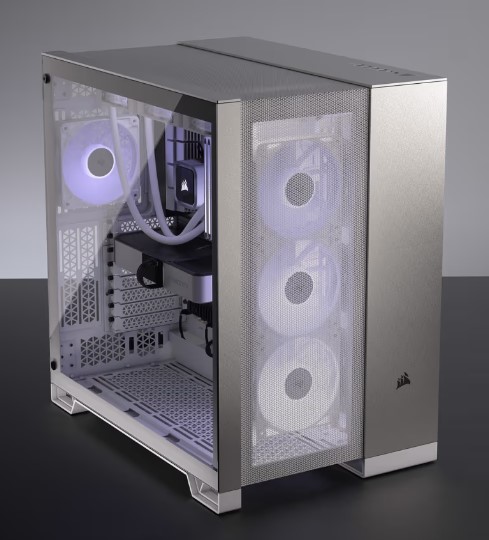
Specifications : Type: Mid-Tower ATX | Colors: Black and White | Motherboard Support: E-ATX (305mm x 277mm), ATX, Micro-ATX, mini-ITX | Dimensions: 481 x 328 x 496 mm | GPU Clearance: 400mm (370mm with front radiator) | CPU Cooler Clearance: 190 mm | PSU Clearance: 225 mm | Ports: 4x USB 3.2 Gen1, 1x USB 3.2 Gen2 Type-C, Audio I/O, Power button, Reset button | Drive Bays: 2x 3.5-inch, 2x 2.5-inch | Included Fans: None
Pros
- Robust build quality
- Stunning design
- Reverse connector motherboard compatibility
- Plenty of cable-management room
- Unique customization options
- Easy to build with
- Superb airflow
Cons
- No included fans
- No 420mm radiator support
- No vertical mount included
- Only 4 drive bays
Aesthetics & Build Quality: The 6500D Airflow expands Corsair’s lineup of dual-chamber cases and absolutely nails the spot in terms of aesthetics. On one side, we have the mesh front panel, which extends to the top. The second chamber, made entirely of steel, is larger than I’ve seen in most chassis. The overall build quality is very sturdy.
Cooling Performance: Thanks to its dual-chamber design and front plus top mesh design, it adds another trophy to Corsair’s excellent Airflow lineup. There is support for up to 13x 120mm fans/9x 140mm fans, but I was disappointed that there is no 420mm radiator support. Nonetheless, it beat out most other ATX cases in my thermal testing.
Features: I like how Corsair has promoted easy customization, with removable case panels that can be replaced by their unique custom panels. GPUs and air coolers of literally any size are supported, and installation was a breeze. But it would have been nice if we had pre-installed fans, and the number of drive bays would have been rather limiting.
What Makes It The Best ATX Case For Airflow?
With the 6500D Airflow, you get tons of features, great airflow, a sleek design with robust, high-quality steel used as the material. The main problem really is the lack of any included fans, as the remaining problems can be dealt with one way or another. So, some fans in the package would have been nice, but it still came out on top as I compared it with other chassis, and so its my Best ATX Case pick.
| Connectivity: 9/10 | Value: 7.5/10 |
| Features: 8/10 | Design: 9/10 |
Corsair 2000D Airflow
Best Mini-ITX Airflow Case
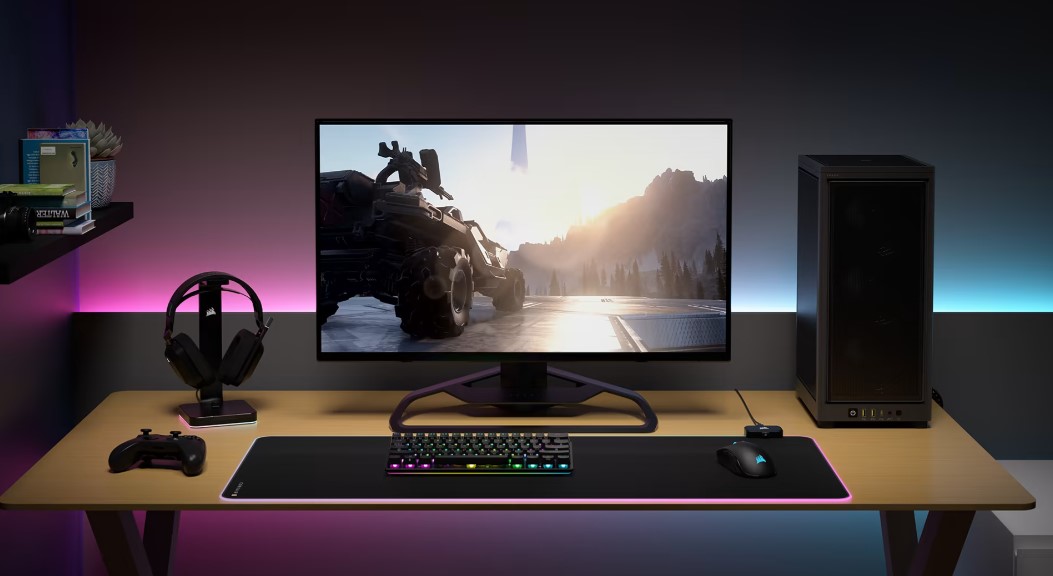
Specifications : Type: SFF Mini-ITX | Colors: Black and White | Motherboard Support: Mini-ITX | Dimensions: 458 x 271 x 200 mm | GPU Clearance: 365 mm | CPU Cooler Clearance: 165 mm | PSU Clearance: 130 mm | Ports: 2x USB 3.2 Gen1, 1x USB 3.2 Type-C, 3.5 mm Audio/Mic Combo | Drive Bays: 3x 2.5-inch | Included Fans: 3x 120mm
Pros
- Unique tower design
- Excellent cooling performance
- Extremely compact
- Supports GPU vertical mounting without riser cable
- Minimalist and sleek-looking
- 3x pre-installed fans
Cons
- Pricey for a mini-ITX chassis
- Not the easiest cable management
Aesthetics & Build Quality: The Corsair 2000D Airflow’s has a “tower” design rather than the cube shape we usually see in Mini-ITX chassis. All the focus is on airflow, as we get removable steel mesh panels on all sides (except the bottom). So, there’s not much offered in terms of aesthetics, but that’s completely fine.
Cooling Performance: With a tall design clearly prioritizing high airflow and 3x pre-installed fans, the 2000D’s approach to high airflow is on point. In my testing, its airflow kept both the CPU and GPU under 60°C as they were stress tested. The noise became a bit noticeable, but that was expected given its all-out mesh design.
Features: First things first: its compact design means it’s great for small desks. The front I/O includes 2x USB 3.2 Gen1 and one USB 3.2 Gen2 Type-C, perfect for its size. Moving on, the air cooler and GPU clearance are excellent. Sadly, though, this chassis doesn’t help mini-ITX cases’ reputation of complicated cable management.
For me, the 2000D Airflow’s design is highly understated, but maybe that’s just me as mesh panels are appealing to me. In any case, the chassis does a stellar job of circulating air through the case and dissipating all the warmth.
– Faizan Ahmed
What Makes It The Best Mini-ITX Airflow Case?
The Corsair 2000D steers away from the traditional cubic design of mini-ITX chassis, focusing more on the height to keep things compact. At the same time, the excess of mesh panels offers great airflow performance, albeit at the cost of noticeable noise output. It also offers decent I/O, pre-installed fans, and support for 360mm radiators, convincing me to pick as the Best Mini-ITX Airflow Case.
| Connectivity: 8/10 | Value: 7/10 |
| Features: 9/10 | Design: 8/10 |
Specifications Comparison
Here are the key specifications of my favorite airflow PC cases:
| Best Airflow PC Cases | Height (mm) | Width (mm) | Depth (mm) | GPU Clearance (mm) | PSU Clearance (mm) | Cooler Clearance (mm) | Max 2.5" SSDs | Max 3.5" HDDs |
|---|---|---|---|---|---|---|---|---|
| LIAN LI LANCOOL III | 523 | 238 | 526 | 435 | 220 | 187 | 12 | 4 |
| Corsair 4000D Airflow | 453 | 230 | 466 | 360 | 220 | 170 | 2 | 2 |
| NZXT H5 Flow | 464 | 447 | 227 | 365 | 185 | 165 | 2 | 1 |
| Corsair 7000D Airflow | 600 | 248 | 550 | 450 | 225 | 190 | 4 | 6 |
| Corsair 6500D Airflow | 496 | 328 | 481 | 400 | 225 | 190 | 3 | 3 |
| Corsair 2000D Airflow | 458 | 200 | 271 | 365 | 130 | 165 | 3 | 0 |
Community Poll
Frequently Asked Questions
Good airflow can be regulated by using the negative configuration where more heat is dissipated, and less air enters the system.
Installing fans at the front, back, and top of the panel is recommended for proper airflow. Using three fans at the front panel and one at the back would be better to direct the airflow in and out of the case.
If the fans are placed at the front panel and act as an intake, all the airflow would be channeled inwards and cool the interior. If the fans at the back are placed as exhausts at the backside simultaneously, all the airflow would be directed outwards.
PC case airflow can be easily figured out by using a smoke source, be it a vape, a fog machine, or incense sticks, and using this source in a box with a small cutout. This cutout has to face the front panel of the PC case, where the installed fans suck the air from the box and direct it inside the case. This allows you to see the practical demonstration and know exactly where the air is flowing.
An optimum airflow in a PC case is usually maintained in the neutral configuration where the cool air enters, and warm air is exhausted evenly. This also delays the cleaning process of the interior as dust is less likely to enter the system.
A good airflow case usually arrives with a Mesh panel in the front, allowing maximum air in or out of the case. Additionally, there is enough space left at the top and bottom to install additional fans or radiators to regulate more airflow.
Recent Updates
- March 5, 2024: I have made some product changes, for instance, the Fractal Design Meshify C was replaced by Corsair 6500D, while the Lian Li O11 Air Mini was replaced by Corsair 2000D, as I found these chassis to be more suitable options after testing them.
- June 8, 2023: A few text changes to improve readability. No products were changed.
Thank you! Please share your positive feedback. 🔋
How could we improve this post? Please Help us. 😔
[Casings & Motherboards Expert]
Faizan Ahmed is a Computer Hardware Specialist and professional writer covering all the ranges of different PC Casings alongside the latest Motherboards. He is the man to read when you’re buying a casing for your PC, need a Motherboard for your specific processor, or are concerned about the socket or CPU Cooler.
Having a keen eye for the details, his research includes the latest updates and technologies implemented in the sector and the quick response to approaching them ASAP. Before working on Tech4Gamers, Faizan has written immensely on freelancing platforms under the Tech niche, ranging from PC Components to different smart devices, software, and even Game Reviews and Guides.
He’s also written on websites like WhatIfGaming and Mondestuff. Faizan is an early PC gamer, and this prolonged interaction with the PC and Games has made him the perfect candidate for expressing his ideas and concepts in words for others in the community.
Get In Touch: faizan@tech4gamers.com


 Threads
Threads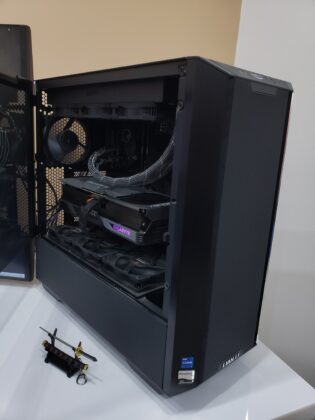
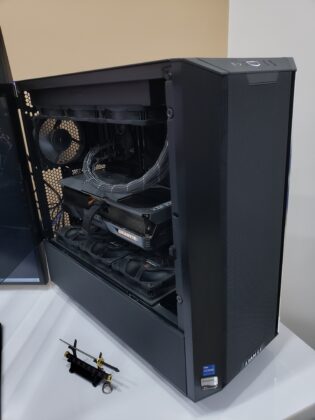
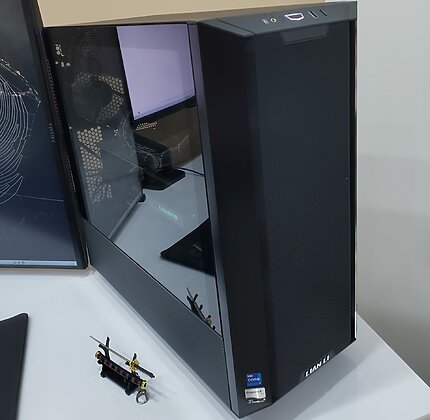

![5 BEST 140mm Case Fans [Expert Picks] Best 140mm Case Fans](https://tech4gamers.com/wp-content/uploads/2023/06/Best-140mm-Case-Fans-218x150.jpg)
